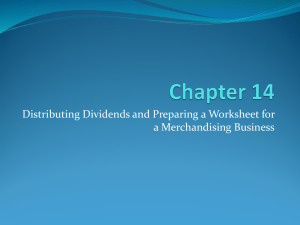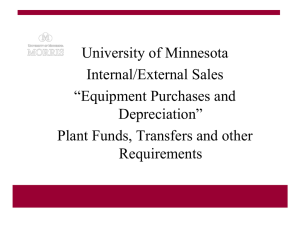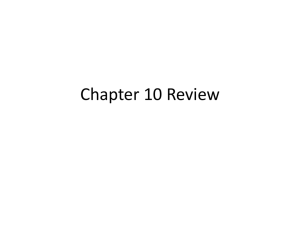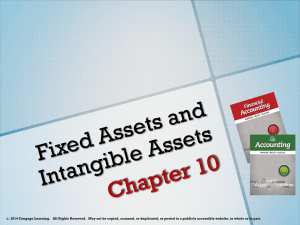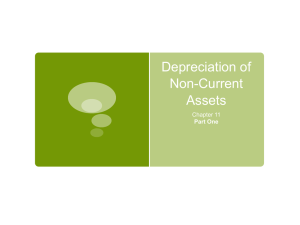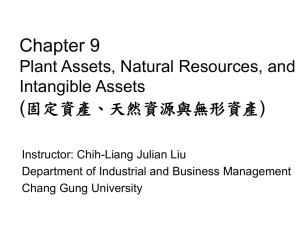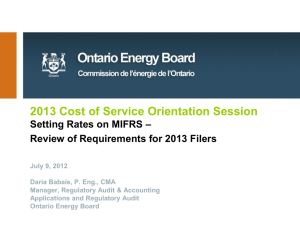Chapter 10
advertisement
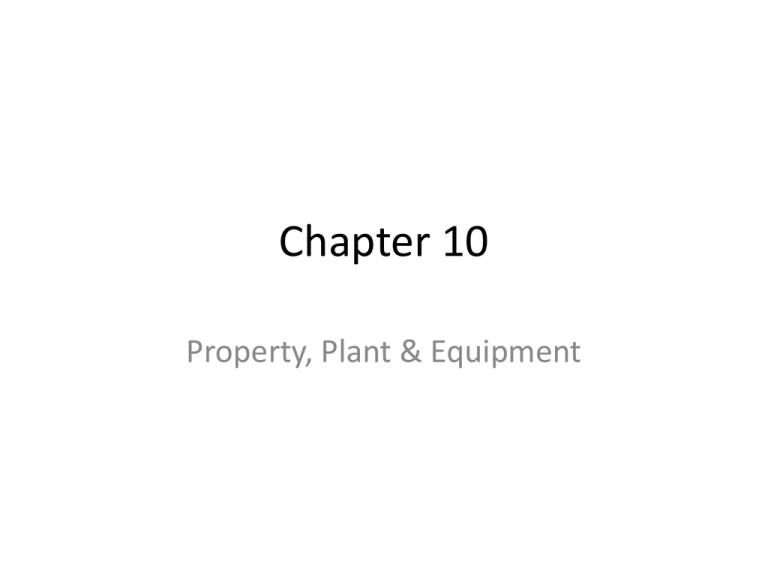
Chapter 10 Property, Plant & Equipment Property, Plant & Equipment • Property, plant, and equipment includes land, buildings, and equipment (machinery, furniture, tools). • Major characteristics include: “Used in operations” and not for resale. Long-term in nature and usually depreciated. Possess physical substance. PP&E Historical Cost • Valued at Historical Cost, reasons include: At acquisition, cost reflects fair value. Historical cost is reliable. Companies should not anticipate gains and losses but should recognize gains and losses only when the asset is sold. Cost of Land • Includes all costs to acquire land and ready it for use. Costs typically include: (1)the purchase price; (2)closing costs, such as title to the land, attorney’s fees, and recording fees; (3)costs of grading, filling, draining, and clearing; (4)assumption of any liens, mortgages, or encumbrances on the property; and (5)Additional land improvements that have an indefinite life. Cost of Buildings • Includes all costs related directly to acquisition or construction. • Costs typically include: (1)materials, labor, and overhead costs incurred during construction and (2)professional fees and building permits. Cost of Equipment Include all costs incurred in acquiring the equipment and preparing it for use. • Costs typically include: (1)purchase price, (2)freight and handling charges (3)insurance on the equipment while in transit, (4)cost of special foundations if required, (5)assembling and installation costs, and (6)costs of conducting trial runs. • Acquisition Costs (a) Money borrowed to pay building contractor : Notes Payable (b) Payment for construction from note proceeds: Buildings (c) Cost of land fill and clearing: Land (d) Delinquent real estate taxes on property assumed: Land (e) Premium on insurance policy during construction: Buildings (f) Refund of 1-month insurance premium because construction completed early: (Buildings) Acquisition Costs • • (g) Architect’s fee on building: Buildings (h) Cost of real estate purchased as a plant site (land $200,000 and building $50,000): Land • (i) Commission fee paid to real estate agency: Land • (j) Installation of fences around property: Land Improvements • (k) Cost of razing and removing building: Land (l) Proceeds from salvage of demolished building: (Land) (m) Cost of parking lots and driveways: Land Improvements (n) Cost of trees and shrubbery (permanent): Land Self-constructed Assets • Costs typically include: (1) Materials and direct labor (2) Overhead can be handled in two ways: 1. Assign no fixed overhead 2. Assign a portion of all overhead to the construction process. – Companies use the second method extensively. Interest Costs During Construction • Three approaches have been suggested to account for the interest incurred in financing the construction. 1. Capitalize no interest during construction 2. Capitalize actual costs incurred during construction (GAAP) 3. Capitalize all cost of funds GAAP requires — capitalizing actual interest (with modification). Consistent with historical cost — all costs incurred to bring the asset to the condition for its intended use. Interest Costs During Construction • Richard Company begins construction on a building early in 2008 and completes construction by the end of the year. Richard incurred total interest costs on borrowing during 2008 in the amount of $325,000. It determines that $165,000 of these interest costs is attributable to expenditures on the new building. Buildings 165,000 Interest Expense 160,000 Cash 325,000 Other Valuation Issues • Companies should record property, plant, and equipment: at the fair value of what they give up or at the fair value of the asset received, whichever is more clearly evident. • Cash Discounts — whether taken or not — generally considered a reduction in the cost of the asset. • Acquiring PP&E • Lump-Sum Purchases Allocate the total cost among the various assets on the basis of their fair market values. • Issuance of Stock The market value of the stock issued is a fair indication of the cost of the property acquired. Contributions of PP&E • Companies should use: the fair value of the asset to establish its value on the books and should recognize contributions received as revenues in the period received. Costs Subsequent to Acquisition • In general, costs incurred to achieve greater future benefits should be capitalized, whereas expenditures that simply maintain a given level of services should be expensed. • To capitalize costs, one of three conditions must be present: Useful life of the asset must be increased. Quantity of units produced from asset must be increased. Quality of units produced must be enhanced. Costs Subsequent to Acquisition • Major Types of Expenditures Additions Improvements and replacements Rearrangement and reinstallation Repairs [See Illustration 10-6, in the text, for summary of normal accounting treatment for these expenditures.] Depreciation • Depreciation is the accounting process of allocating the cost of tangible assets to expense in a systematic and rational manner to those periods expected to benefit from the use of the asset. • Allocating costs of long-term assets: Fixed assets = Depreciation expense Intangibles = Amortization expense Natural resources = Depletion expense Depreciation • Factors Involved in the Depreciation Process (1)What depreciable base is to be used? (2)What is the asset’s useful life? (3)What method of cost allocation is best? Depreciation Methods • The profession requires the method employed be “systematic and rational.” Examples include: (1)Activity method (units of use or production). (2)Straight-line method. (3)Sum-of-the-years’-digits. (4)Declining-balance method. Calculating Depreciation • Robert Parish Corporation purchased a new machine for its assembly process on September 30, 2007. The cost of this machine was $117,900. The company estimated that the machine would have a salvage value of $12,900 at the end of its service life. Its life is estimated at 5 years and its working hours are estimated at 1,000 hours. Year-end is December 31. • (a) Straight-line depreciation. • (b) Activity method. • (c) Sum-of-the-years’-digits. • (d) Double-declining balance. Straight-line Depreciation Year Depreciable Base Annual Expense 2007 $ 105,000 / 5 = $ 21,000 2008 105,000 / 5 = 2009 105,000 / 5 2010 105,000 / 2011 105,000 2012 105,000 Years Current Year Expense Partial Year x 5,250 $ 5,250 21,000 21,000 26,250 = 21,000 21,000 47,250 5 = 21,000 21,000 68,250 / 5 = 21,000 21,000 89,250 / 5 = 21,000 15,750 105,000 x 3/12 9/12 = = $ $ 105,000 Journal entry: 2007 Accum. Deprec. Depreciation expense Accumultated depreciation 5,250 5,250 Activity Method ($105,000 / 1,000 hours = $105 per hour) Year (Given) Hours Used Rate per Hours Annual Expense Partial Year Current Year Expense Accum. Deprec. 2007 200 x $105 = $ 21,000 $ 21,000 $ 21,000 2008 150 x 105 = 15,750 15,750 36,750 2009 250 x 105 = 26,250 26,250 63,000 2010 300 x 105 = 31,500 31,500 94,500 2011 100 x 105 = 10,500 10,500 105,000 1,000 $ 105,000 Journal entry: 2007 Depreciation expense Accumultated depreciation 21,000 21,000 Sum of the Years’ Digits Year Depreciable Base 2007 $ 105,000 x 2008 105,000 2009 Annual Expense Years 5/15 = $ 35,000 x 4.75/15 = 105,000 x 2010 105,000 2011 2012 Partial Year 3/12 $ $ 8,750 33,250 33,250 42,000 3.75/15 = 26,250 26,250 68,250 x 2.75/15 = 19,250 19,250 87,500 105,000 x 1.75/15 = 12,250 12,250 99,750 105,000 x .75/15 5,250 5,250 105,000 $ 105,000 Journal entry: 2007 Accum. Deprec. 8,750 = x Current Year Expense Depreciation expense Accumultated depreciation 8,750 8,750 Double Declining Balance (note: calculations are incorrect) Year Depreciable Base Rate per Year Annual Expense 2007 $ 117,900 x 40% = 2008 106,110 x 40% = 2009 63,666 x 40% 2010 38,200 x 2011 2012 $ 47,160 x Partial Year 3/12 Current Year Expense = $ 11,790 $ 11,790 42,444 42,444 54,234 = 25,466 25,466 79,700 40% = 15,280 15,280 94,980 22,920 x 40% = 9,168 9,168 104,148 13,752 x 40% = 5,501 852 105,000 Plug $ 105,000 Journal entry: 2007 Accum. Deprec. Depreciation expense Accumultated depreciation 11,790 11,790 Depreciation Issues (1) How should depreciation be computed for partial periods? Companies normally compute depreciation on the basis of the nearest full month. (2) How are revisions in depreciation rates handled? • Changes in Depreciation Rate Accounted for in the period of change and future periods (Change in Estimate) Not handled retrospectively Not considered errors or extraordinary items Sale of Plant Assets • Sim City Corporation owns machinery that cost $20,000 when purchased on January 1, 2005. Depreciation has been recorded at a rate of $3,000 per year, resulting in a balance in accumulated depreciation of $9,000 at December 31, 2007. The machinery is sold on September 1, 2008, for $10,500. Prepare journal entries to (a) update depreciation for 2008 and (b) record the sale. (a) Depreciation Expense ($3,000 x 8/12) 2,000 Accumulated Depreciation 2,000 (b) Cash 10,500 Accumulated Depreciation 11,000 Machinery 20,000 Gain on Sale 1,500 Involuntary Conversion • Sometimes an asset’s service is terminated through some type of involuntary conversion such as fire, flood, theft, or condemnation. • Companies report the difference between the amount recovered (e.g., from a condemnation award or insurance recovery), if any, and the asset’s book value as a gain or loss. • They treat these gains or losses like any other type of disposition. Exchanges • Ordinarily accounted for on the basis of: the fair value of the asset given up or the fair value of the asset received, whichever is clearly more evident. • Companies should recognize immediately any gains or losses on the exchange when the transaction has commercial substance (future cash flows change as a result of the transaction). • Accounting for Exchanges • * If cash is 25% or more of the fair value of the exchange, recognize entire gain because earnings process is complete. Exchanges—Calculating Gain or Loss • Companies recognize a loss immediately whether the exchange has commercial substance or not. • Rationale: Companies should not value assets at more than their cash equivalent price; if the loss were deferred, assets would be overstated. Fair value of equipment received Cash received / paid Less: Bookvalue of equipment ($28,000-19,000) ($28,000-10,000) Gain or (Loss) on Exchange Arruza $12,500 3,000 LoBianco $15,500 (3,000) (9,000) $6,500 (18,000) ($5,500) Summary of Gain and Loss Recognition on Exchanges of Nonmonetary Assets Lacks Commercial Substance PP&E Disclosures Depreciating assets, use Accumulated Depreciation. • Depleting assets may include use of Accumulated Depletion account, or the direct reduction of asset. • Basis of valuation (cost) Pledges, liens, and other commitments Depreciation expense for the period. Balances of major classes of depreciable assets. Accumulated depreciation. A description of the depreciation methods used. Ratio Analysis Return on Sales: Net Income Sales Asset Turnover: Sales Average Total Assets Return on Assets: Net income Average Total Assets PP&E Disclosure Issues • Magnitude depends on industry & business strategy. • Age of fixed assets can be important; use average age & other ratios • Various acquisition, disposal & write-off issues • Occasionally related to fraud, such as Waste Management Average Age Calculations • Average age = (accumulated depreciation / depreciation expense) • Average depreciable life = (ending gross investment / depreciation expense) • Average age % = (accumulated depreciation / ending gross investment) • Older plants are typically less efficient & subject to breakdowns

